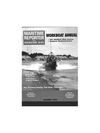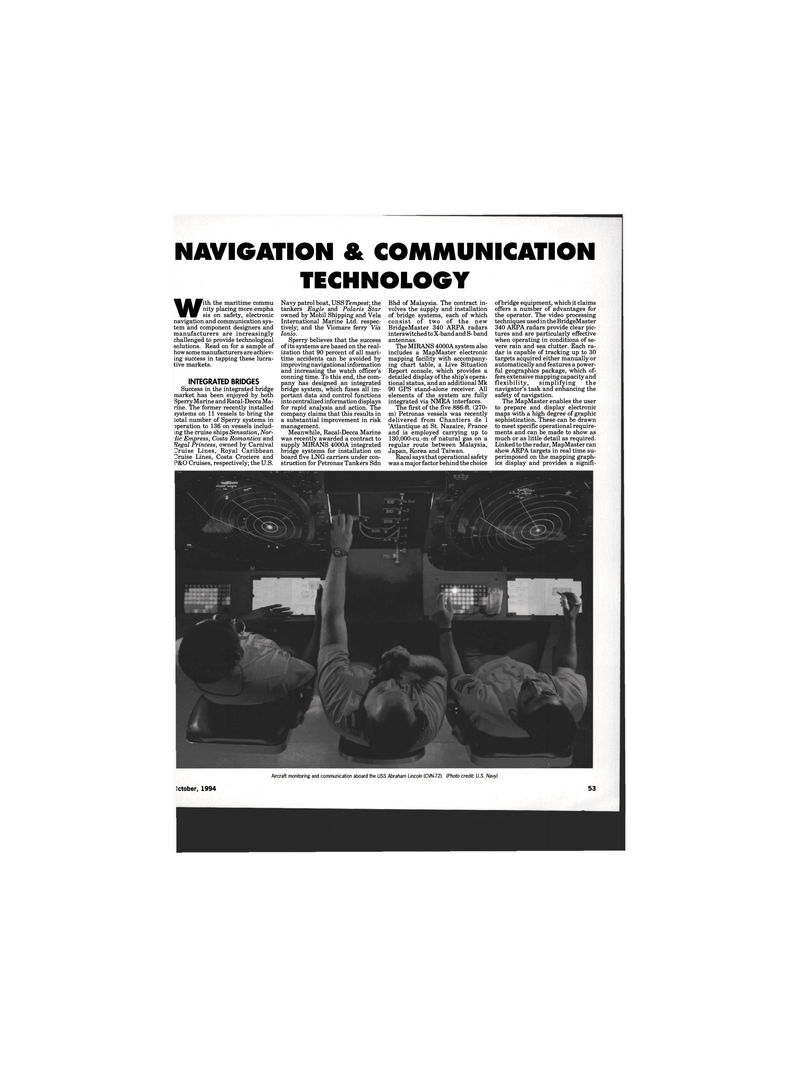
Page 66: of Maritime Reporter Magazine (October 1994)
Read this page in Pdf, Flash or Html5 edition of October 1994 Maritime Reporter Magazine
NAVIGATION & COMMUNICATION
TECHNOLOGY
With the maritime commu nity placing more empha sis on safety, electronic navigation and communication sys- tem and component designers and manufacturers are increasingly challenged to provide technological solutions. Read on for a sample of how some manufacturers are achiev- ing success in tapping these lucra- tive markets.
INTEGRATED BRIDGES
Success in the integrated bridge market has been enjoyed by both
Sperry Marine and Racal-Decca Ma- rine. The former recently installed systems on 11 vessels to bring the total number of Sperry systems in operation to 136 on vessels includ- ing the cruise ships Sensation, Nor- dic Empress, Costa Romantica and
Regal Princess, owned by Carnival
Cruise Lines, Royal Caribbean
Cruise Lines, Costa Crociere and
P&O Cruises, respectively; the U.S.
Navy patrol boat, USS Tempest; the tankers Eagle and Polaris Star owned by Mobil Shipping and Vela
International Marine Ltd. respec- tively; and the Viomare ferry Via lonio.
Sperry believes that the success of its systems are based on the real- ization that 90 percent of all mari- time accidents can be avoided by improving navigational information and increasing the watch officer's conning time. To this end, the com- pany has designed an integrated bridge system, which fuses all im- portant data and control functions into centralized information displays for rapid analysis and action. The company claims that this results in a substantial improvement in risk management.
Meanwhile, Racal-Decca Marine was recently awarded a contract to supply MIRANS 4000A integrated bridge systems for installation on board five LNG carriers under con- struction for Petronas Tankers Sdn
Bhd of Malaysia. The contract in- volves the supply and installation of bridge systems, each of which consist of two of the new
BridgeMaster 340 ARPA radars interswitched to X-band and S- band antennas
The MIRANS 4000A system also includes a MapMaster electronic mapping facility with accompany- ing chart table, a Live Situation
Report console, which provides a detailed display of the ship's opera- tional status, and an additional Mk 90 GPS stand-alone receiver. All elements of the system are fully integrated via NMEA interfaces.
The first of the five 886-ft. (270- m) Petronas vessels was recently delivered from Chantiers de 1 'Atlantique at St. Nazaire, France and is employed carrying up to 130,000-cu.-m of natural gas on a regular route between Malaysia,
Japan, Korea and Taiwan.
Racal says that operational safety wasamajor factor behind the choice of bridge equipment, which it claims offers a number of advantages for the operator. The video processing techniques used in the BridgeMaster 340 ARPA radars provide clear pic- tures and are particularly effective when operating in conditions of se- vere rain and sea clutter. Each ra- dar is capable of tracking up to 30 targets acquired either manually or automatically and features a power- ful geographies package, which of- fers extensive mapping capacity and flexibility, simplifying the navigator's task and enhancing the safety of navigation.
The MapMaster enables the user to prepare and display electronic maps with a high degree of graphic sophistication. These can be drawn to meet specific operational require- ments and can be made to show as much or as little detail as required.
Linked to the radar, MapMaster can show ARPA targets in real time su- perimposed on the mapping graph- ics display and provides a signifi- )ctober, 1994
Aircraft monitoring and communication aboard the USS Abraham Lincoln (CVN-72). (Photo credit: U.S. Navy) 53

 65
65

 67
67
